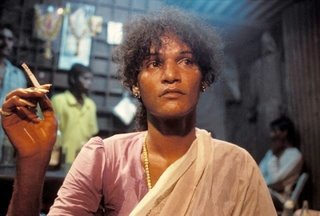Here's an intro to the documentary that draws 70% of the 200+ seating capacity auditorium:
(Note: if you are not feeling easy with transgender issues, you are not obliged to continue.)

German director Thomas Wartmann directs a documentary that explores the lives of hijras (eunuchs) in India, through the eyes of Anita Khemka, an Indian female photographer. Set in Bombay, Anita interviewed 3 hijras on why do they want to lead such a life, and life on being a hijra.
For the next few days, Anita entered the lives of 3 hijras. They are: Laxmi - a dance instructor who prostitutes himself. He is the lucky one among the three, where he is more well off than anybody else. He did not go through the castration ceremony, for he beliefs that the body was given by his parents. Thus, he did not remove his manhood as he honor his father and love his mother. He chosen the life of being a hijra for he feels that he is a woman trapped in a man's body.
Laxmi - a dance instructor who prostitutes himself. He is the lucky one among the three, where he is more well off than anybody else. He did not go through the castration ceremony, for he beliefs that the body was given by his parents. Thus, he did not remove his manhood as he honor his father and love his mother. He chosen the life of being a hijra for he feels that he is a woman trapped in a man's body.
Asha - a street begger who bless amorous  couples for a token sum of fees. Run away from his home at the age of 13, Asha was found on the streets by a group of hijras after not having sufficient food for 3 months. Since 10, he has been acting in a feminine way. At the point of time when he was found by the group of hijras, he knew the life he wanted in future. She was formally a prostitute, and told Anita a fact based on her experience: that man prefers having sex with a hijras than having sex with a woman. And their customers comes from all walks of life: workers, farmers, businessmen, rich, poor... (and towards the end of the documentary, it was mentioned that Asha was kicked out from her former group of hijras, but she was accepted by another group of hijras.)
couples for a token sum of fees. Run away from his home at the age of 13, Asha was found on the streets by a group of hijras after not having sufficient food for 3 months. Since 10, he has been acting in a feminine way. At the point of time when he was found by the group of hijras, he knew the life he wanted in future. She was formally a prostitute, and told Anita a fact based on her experience: that man prefers having sex with a hijras than having sex with a woman. And their customers comes from all walks of life: workers, farmers, businessmen, rich, poor... (and towards the end of the documentary, it was mentioned that Asha was kicked out from her former group of hijras, but she was accepted by another group of hijras.)
Rhamba - she lives in a temple together with a group of hijras, where she earns a living by performing ritual ceremonies, such as blessing a new born baby and exorcism. Apart from working in the temple, she also perform dances at go-go bars, where she earns an extra income to support herself.
It is too much and difficult for me to lay out why is it that they had chosen a life of living a life of an opposite sex. Mabey is it becuase they feel that they are a soul trapped in a body that doesn't belongs to them? Or is it their culture that makes hijras a norm? Or is it just that being a hijra means one can solved a problem of their own?
I do not know, and i leave the theatres with questions.